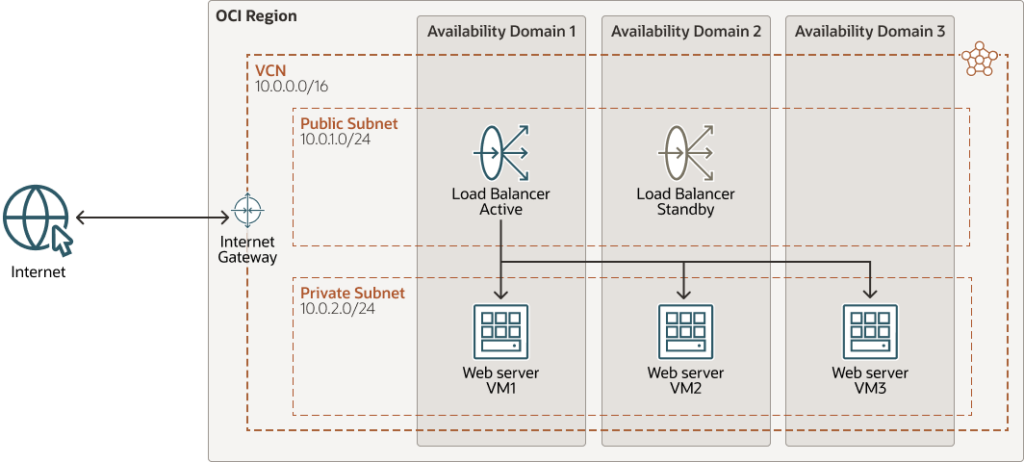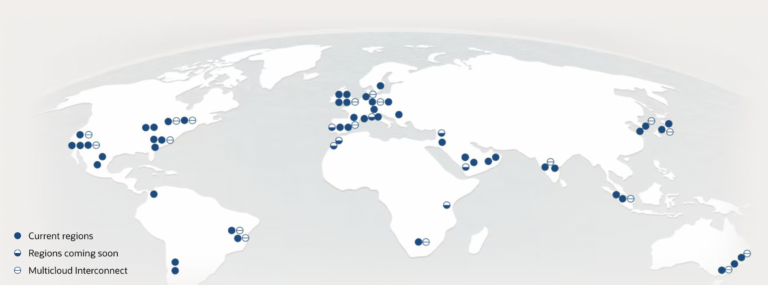As of August 2024, Oracle Cloud Infrastructure (OCI) boasts more than 45 active regions and over 100 Availability Domains globally. This impressive infrastructure size is comparable to that of Microsoft Azure and AWS, offering a vast network of data centers across continents. Below, we’ll explore Oracle’s cloud regions, availability domains, expansion plans, and how you can optimize your Oracle Cloud footprint.
Table of Oracle Active Regions
Here’s a comprehensive table of Oracle Cloud regions, their respective cities, and the number of availability domains. This information is based on the latest data available from Oracle Cloud’s official documentation.
| Region Name | Region Identifier | Region Location | Region Key | Realm Key | Availability Domains |
|---|---|---|---|---|---|
| Australia East (Sydney) | ap-sydney-1 | Sydney, Australia | SYD | OC1 | 1 |
| Australia Southeast (Melbourne) | ap-melbourne-1 | Melbourne, Australia | MEL | OC1 | 1 |
| Brazil East (Sao Paulo) | sa-saopaulo-1 | Sao Paulo, Brazil | GRU | OC1 | 1 |
| Brazil Southeast (Vinhedo) | sa-vinhedo-1 | Vinhedo, Brazil | VCP | OC1 | 1 |
| Canada Southeast (Montreal) | ca-montreal-1 | Montreal, Canada | YUL | OC1 | 1 |
| Canada Southeast (Toronto) | ca-toronto-1 | Toronto, Canada | YYZ | OC1 | 1 |
| Chile Central (Santiago) | sa-santiago-1 | Santiago, Chile | SCL | OC1 | 1 |
| Chile West (Valparaiso) | sa-valparaiso-1 | Valparaiso, Chile | VAP | OC1 | 1 |
| Colombia Central (Bogota) | sa-bogota-1 | Bogota, Colombia | BOG | OC1 | 1 |
| France Central (Paris) | eu-paris-1 | Paris, France | CDG | OC1 | 1 |
| France South (Marseille) | eu-marseille-1 | Marseille, France | MRS | OC1 | 1 |
| Germany Central (Frankfurt) | eu-frankfurt-1 | Frankfurt, Germany | FRA | OC1 | 3 |
| India South (Hyderabad) | ap-hyderabad-1 | Hyderabad, India | HYD | OC1 | 1 |
| India West (Mumbai) | ap-mumbai-1 | Mumbai, India | BOM | OC1 | 1 |
| Israel Central (Jerusalem) | il-jerusalem-1 | Jerusalem, Israel | MTZ | OC1 | 1 |
| Italy Northwest (Milan) | eu-milan-1 | Milan, Italy | LIN | OC1 | 1 |
| Japan Central (Osaka) | ap-osaka-1 | Osaka, Japan | KIX | OC1 | 1 |
| Japan East (Tokyo) | ap-tokyo-1 | Tokyo, Japan | NRT | OC1 | 1 |
| Mexico Central (Queretaro) | mx-queretaro-1 | Queretaro, Mexico | QRO | OC1 | 1 |
| Mexico Northeast (Monterrey) | mx-monterrey-1 | Monterrey, Mexico | MTY | OC1 | 1 |
| Netherlands Northwest (Amsterdam) | eu-amsterdam-1 | Amsterdam, Netherlands | AMS | OC1 | 1 |
| Saudi Arabia Central (Riyadh) | me-riyadh-1 | Riyadh, Saudi Arabia | RUH | OC1 | 1 |
| Saudi Arabia West (Jeddah) | me-jeddah-1 | Jeddah, Saudi Arabia | JED | OC1 | 1 |
| Serbia Central (Jovanovac) | eu-jovanovac-1 | Jovanovac,Serbia | BEG | OC20 | 1 |
| Singapore (Singapore) | ap-singapore-1 | Singapore,Singapore | SIN | OC1 | 1 |
| Singapore West (Singapore) | ap-singapore-2 | Singapore,Singapore | XSP | OC1 | 1 |
| South Africa Central (Johannesburg) | af-johannesburg-1 | Johannesburg, South Africa | JNB | OC1 | 1 |
| South Korea Central (Seoul) | ap-seoul-1 | Seoul, South Korea | ICN | OC1 | 1 |
| South Korea North (Chuncheon) | ap-chuncheon-1 | Chuncheon, South Korea | YNY | OC1 | 1 |
| Spain Central (Madrid) | eu-madrid-1 | Madrid, Spain | MAD | OC1 | 1 |
| Sweden Central (Stockholm) | eu-stockholm-1 | Stockholm, Sweden | ARN | OC1 | 1 |
| Switzerland North (Zurich) | eu-zurich-1 | Zurich, Switzerland | ZRH | OC1 | 1 |
| UAE Central (Abu Dhabi) | me-abudhabi-1 | Abu Dhabi, UAE | AUH | OC1 | 1 |
| UAE East (Dubai) | me-dubai-1 | Dubai, UAE | DXB | OC1 | 1 |
| UK South (London) | uk-london-1 | London, United Kingdom | LHR | OC1 | 3 |
| UK West (Newport) | uk-cardiff-1 | Newport, United Kingdom | CWL | OC1 | 1 |
| US East (Ashburn) | us-ashburn-1 | Ashburn, VA | IAD | OC1 | 3 |
| US Midwest (Chicago) | us-chicago-1 | Chicago, IL | ORD | OC1 | 3 |
| US West (Phoenix) | us-phoenix-1 | Phoenix, AZ | PHX | OC1 | 3 |
| US West (San Jose) | us-sanjose-1 | San Jose, CA | SJC | OC1 | 1 |
Explanation of Oracle Regions and Availability Domains

Oracle Cloud Infrastructure (OCI) operates with a structure that offers high availability and fault tolerance.
Oracle Regions: Regions in Oracle Cloud are separate geographical locations worldwide, each containing multiple availability domains. Regions are isolated from each other to ensure that a failure in one region does not affect others. Choosing a region depends on factors like data sovereignty, compliance, latency, and customer requirements. Strategically deploying resources across multiple regions helps with disaster recovery and achieving compliance with data residency regulations.
Availability Domains: Within a region, Oracle Cloud offers availability domains, which are isolated data centers equipped with independent power, cooling, and network infrastructure. Availability domains within a region are interconnected via a low-latency, high-bandwidth network. By deploying resources across multiple availability domains, businesses can achieve redundancy and fault tolerance. If one availability domain fails, the others continue to operate, ensuring continuous business operations.
Oracle’s two-tiered approach of Regions and Availability Domains allows customers to optimize their cloud architecture for performance, reliability, and disaster recovery.
Oracle cloud region expansion plan
Oracle continues to expand its cloud data center footprint aggressively to cater to the growing demand for cloud services. Oracle plans to add new regions and expand existing ones to enhance global coverage and cater to region-specific compliance requirements. Recently Oracle cloud announced that they will spend 10 Billion in 2025 to expand datacenters. Oracle CTO said: “We’re building an AI data center in the United States where you could park eight Boeing 747s nose-to-tail in that one data center”.
Oracle’s expansion strategy ensures low-latency connectivity, localized compliance, and improved performance for its customers worldwide.
Wrap Up: Optimizing Your Oracle Cloud Footprint
Understanding Oracle Cloud regions and availability domains is critical for optimizing your cloud environment. Factors such as latency, data residency requirements, and cost considerations play a significant role in choosing the right regions and availability domains for your deployments. For instance, deploying services closer to your end-users minimizes latency, while certain regions may offer more competitive pricing or compliance benefits.
Managing a multi-region cloud environment can become complex, leading to “shadow IT” or unexpected costs from underutilized resources. This is where tools like Holori can be invaluable.
Holori serves as an automated cloud mapping tool, providing a comprehensive view of your entire Oracle Cloud Infrastructure. It identifies resources spread across regions and availability domains and offers insights into cost management and optimization. By visualizing your OCI environment, Holori helps you detect “zombie resources” and underutilized assets, enabling you to streamline your cloud spending.
Leverage Holori’s capabilities to gain complete visibility and control over your Oracle Cloud footprint, ensuring cost-efficiency and peak performance.
Try it out now for free: https://app.holori.com/






